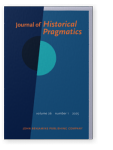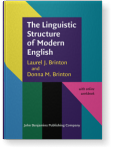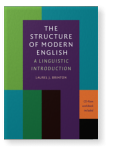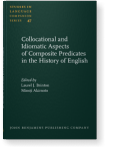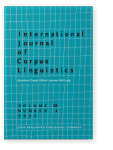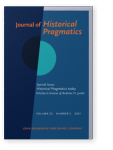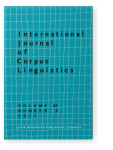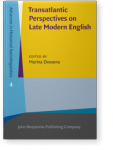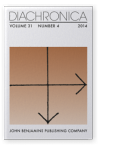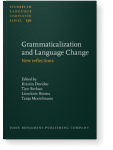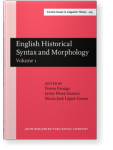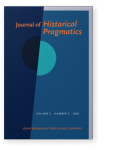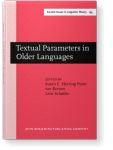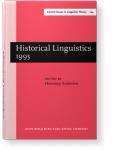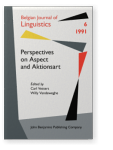Laurel J. Brinton
List of John Benjamins publications for which Laurel J. Brinton plays a role.
Journal
The Linguistic Structure of Modern English
Laurel J. Brinton and Donna M. Brinton
[Not in series, 156] 2010. xx, 426 pp.
Subjects Electronic/Multimedia Products | English linguistics | Germanic linguistics | Theoretical linguistics
Historical Linguistics 1999: Selected papers from the 14th International Conference on Historical Linguistics, Vancouver, 9–13 August 1999
Edited by Laurel J. Brinton
[Current Issues in Linguistic Theory, 215] 2001. xii, 389 pp.
Subjects Historical linguistics
The Structure of Modern English: A linguistic introduction
Laurel J. Brinton
[Not in series, 94] 2000. xxii, 335 pp. (incl. workbook on CD-rom)
Subjects Electronic/Multimedia Products | English linguistics | Germanic linguistics | Theoretical linguistics
Collocational and Idiomatic Aspects of Composite Predicates in the History of English
Edited by Laurel J. Brinton and Minoji Akimoto
[Studies in Language Companion Series, 47] 1999. xiv, 283 pp.
Subjects English linguistics | Germanic linguistics | Historical linguistics | Syntax
2024 The rise of what -general extenders in English Journal of Historical Pragmatics 25:1, pp. 104–136 | Article
General extenders (ges) are elements such as and so forth occurring at the right periphery. On the referential level, they implicate a set, but they also serve a range of discourse-pragmatic functions, such as hedging and interpersonal relations. Some sociolinguistic studies have seen the… read more
2023 “You betcha I’m a ’Merican”: The rise of YOU BET as a pragmatic marker International Journal of Corpus Linguistics 28:4, pp. 528–558 | Article
This article studies you bet and related phrases when they are used as a parenthetical and as a free-standing response. Drawing on a range of corpora, we provide both contemporary and historical perspectives on the set of pragmatic expressions that has largely escaped scholars’ attention.… read more
2021 Responding to thanks: From you’re welcome to you bet Historical Pragmatics today: Articles in honour of Andreas H. Jucker, Taavitsainen, Irma and Jonathan Culpeper (eds.), pp. 180–201 | Article
A variety of forms serve as responses to thanks in Present-day English, albeit infrequently. Such responses minimize the debt incurred by the thanker and serve purposes of negative politeness. The history of responses to thanks has received only brief attention (Jacobsson 2002; Jucker 2020;… read more
2020 The development and pragmatic function of a non-inference marker: That is not to say (that) Corpora and the Changing Society: Studies in the evolution of English, Rautionaho, Paula, Arja Nurmi and Juhani Klemola (eds.), pp. 251–276 | Chapter
That is not to say (that) is an introductory clause refuting an inference that could be drawn from the previous discourse; it often occurs in a negative context (with a positive reading) and is characteristic of written genres, with lowest frequency in fiction. The earliest… read more
2020 A far from simple matter revisited: The ongoing grammaticalization of far from Late Modern English: Novel encounters, Kytö, Merja and Erik Smitterberg (eds.), pp. 271–293 | Chapter
In Present-day English far from belongs to a class of constructions (close to, near to, next to) which have undergone grammaticalization and/or constructionalization. The present corpus-based, diachronic study shows that the development of far from appears to be a clear case of grammaticalization,… read more
2015 Studying real-time change in the adverbial subjunctive: The value of the Bank of Canadian English Transatlantic Perspectives on Late Modern English, Dossena, Marina (ed.), pp. 13–36 | Article
The dearth of real-time studies of the histories of transatlantic English varieties can be attributed to the lack of readily accessible, electronic corpora. However, for Canadian English (CanE) we now have the Bank of Canadian English (BCE), which consists of c. 2.5 million words from written and… read more
2012 “The ghosts of old morphology”: Lexicalization or (de)grammaticalization? Grammaticalization and Language Change: New reflections, Davidse, Kristin, Tine Breban, Lieselotte Brems and Tanja Mortelmans (eds.), pp. 135–166 | Article
“Ghost” inflectional morphology that has lost its grammatical function but remains as phonetic material has been argued to have undergone lexicalization (since the inflection becomes an unanalyzable part of the lexical item and emerges as “more lexical”) and/or degrammaticalization (since the… read more
2008 'Where grammar and lexis meet:' Composite predicates in English Theoretical and Empirical Issues in Grammaticalization, Seoane, Elena and María José López-Couso (eds.), pp. 33–53 | Article
2007 Rise of the adverbial conjunctions {any, each, every} time Connectives in the History of English, Lenker, Ursula and Anneli Meurman-Solin (eds.), pp. 77–96 | Article
2007 Lexicalization and grammaticalization all over again Historical Linguistics 2005: Selected papers from the 17th International Conference on Historical Linguistics, Madison, Wisconsin, 31 July - 5 August 2005, Salmons, Joseph C. and Shannon Dubenion-Smith (eds.), pp. 3–19 | Article
2005 Processes underlying the development of pragmatic markers: The case of (I) say Opening Windows on Texts and Discourses of the Past, Skaffari, Janne, Matti Peikola, Ruth Carroll, Risto Hiltunen and Brita Wårvik (eds.), pp. 279–299 | Article
English(I) sayexhibits a variety of uses as a conjunction (meaning ‘suppose’), an adverb (meaning ‘about’ or ‘for example’), and a pragmatic marker (preceding questions, expressing surprise, evoking the hearer's attention, clarifying, or emphasising). Using the historical development of these forms… read more
2004 Subject clitics in English: A case of degrammaticalization?* Corpus Approaches to Grammaticalization in English, Lindquist, Hans and Christian Mair (eds.), pp. 227–256 | Article
As a counterexample to unidirectionality in grammaticalization, Newmeyer (1998:270) cites the loss of second-person singular subject clitics, e.g., in hastou and wiltou, in 16th century English (Kroch et al. 1982). These forms are a common, albeit optional, feature of Middle English. Though full… read more
2002 Grammaticalization versus lexicalization reconsidered: On the late use of temporal adverbs English Historical Syntax and Morphology: Selected papers from 11 ICEHL, Santiago de Compostela, 7–11 September 2000, Fanego, Teresa, Javier Pérez-Guerra and María José López-Couso (eds.), pp. 67–97 | Article
2001 From matrix clause to pragmatic marker: The history of look-forms Journal of Historical Pragmatics 2:2, pp. 177–199 | Article
The interpersonal pragmatic markers (now) look (here), look you, lookee, lookahere, and lookit are shown to be the result of originally free matrix clauses which become syntactically fixed, are reanalyzed as sentence adjuncts, and undergo internal coalescence, a process which began in the… read more
2000 The Importance of Discourse Types in Grammaticalization: The case of anon Textual Parameters in Older Languages, Herring, Susan C., Pieter van Reenen and Lene Schøsler (eds.), pp. 139–162 | Article
1999 Chapter 2: The Origin of the Composite Predicate in Old English Collocational and Idiomatic Aspects of Composite Predicates in the History of English, Brinton, Laurel J. and Minoji Akimoto (eds.), pp. 21–58 | Chapter
1999 Chapter 1: Introduction Collocational and Idiomatic Aspects of Composite Predicates in the History of English, Brinton, Laurel J. and Minoji Akimoto (eds.), pp. 1–20 | Chapter
1995 Functional renewal Historical Linguistics 1993: Selected papers from the 11th International Conference on Historical Linguistics, Los Angeles, 16–20 August 1993, Andersen, Henning (ed.), pp. 33–48 | Article
1993 Episode Boundary Markers in Old English Discourse Historical Linguistics 1989: Papers from the 9th International Conference on Historical Linguistics, New Brunswick, 14–18 August 1989, Aertsen, Henk and Robert J. Jeffers (eds.), pp. 73–90 | Article
1991 The Mass/Count Distinction and Aktionsart: The Grammar of Iteratives and Habituais Perspectives on Aspect and Aktionsart, Vetters, Carl and Willy Vandeweghe (eds.), pp. 47–69 | Article
1990 The stylistic function of ME gan reconsidered Papers from the 5th International Conference on English Historical Linguistics, Adamson, Sylvia M., Vivien A. Law, Nigel Vincent and Susan Wright (eds.), pp. 31–54 | Article
